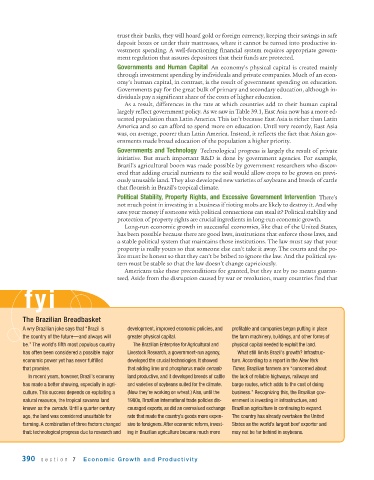Page 432 - Krugmans Economics for AP Text Book_Neat
P. 432
trust their banks, they will hoard gold or foreign currency, keeping their savings in safe
deposit boxes or under their mattresses, where it cannot be turned into productive in-
vestment spending. A well -functioning financial system requires appropriate govern-
ment regulation that assures depositors that their funds are protected.
Governments and Human Capital An economy’s physical capital is created mainly
through investment spending by individuals and private companies. Much of an econ-
omy’s human capital, in contrast, is the result of government spending on education.
Governments pay for the great bulk of primary and secondary education, although in-
dividuals pay a significant share of the costs of higher education.
As a result, differences in the rate at which countries add to their human capital
largely reflect government policy. As we saw in Table 39.1, East Asia now has a more ed-
ucated population than Latin America. This isn’t because East Asia is richer than Latin
America and so can afford to spend more on education. Until very recently, East Asia
was, on average, poorer than Latin America. Instead, it reflects the fact that Asian gov-
ernments made broad education of the population a higher priority.
Governments and Technology Technological progress is largely the result of private
initiative. But much important R&D is done by government agencies. For example,
Brazil’s agricultural boom was made possible by government researchers who discov-
ered that adding crucial nutrients to the soil would allow crops to be grown on previ-
ously unusable land. They also developed new varieties of soybeans and breeds of cattle
that flourish in Brazil’s tropical climate.
Political Stability, Property Rights, and Excessive Government Intervention There’s
not much point in investing in a business if rioting mobs are likely to destroy it. And why
save your money if someone with political connections can steal it? Political stability and
protection of property rights are crucial ingredients in long -run economic growth.
Long - run economic growth in successful economies, like that of the United States,
has been possible because there are good laws, institutions that enforce those laws, and
a stable political system that maintains those institutions. The law must say that your
property is really yours so that someone else can’t take it away. The courts and the po-
lice must be honest so that they can’t be bribed to ignore the law. And the political sys-
tem must be stable so that the law doesn’t change capriciously.
Americans take these preconditions for granted, but they are by no means guaran-
teed. Aside from the disruption caused by war or revolution, many countries find that
fyi
The Brazilian Breadbasket
A wry Brazilian joke says that “Brazil is development, improved economic policies, and profitable and companies began putting in place
the country of the future—and always will greater physical capital. the farm machinery, buildings, and other forms of
be.” The world’s fifth most populous country The Brazilian Enterprise for Agricultural and physical capital needed to exploit the land.
has often been considered a possible major Livestock Research, a government- run agency, What still limits Brazil’s growth? Infrastruc-
economic power yet has never fulfilled developed the crucial technologies. It showed ture. According to a report in the New York
that promise. that adding lime and phosphorus made cerrado Times, Brazilian farmers are “concerned about
In recent years, however, Brazil’s economy land productive, and it developed breeds of cattle the lack of reliable highways, railways and
has made a better showing, especially in agri- and varieties of soybeans suited for the climate. barge routes, which adds to the cost of doing
culture. This success depends on exploiting a (Now they’re working on wheat.) Also, until the business.” Recognizing this, the Brazilian gov-
natural resource, the tropical savanna land 1980s, Brazilian international trade policies dis- ernment is investing in infrastructure, and
known as the cerrado. Until a quarter century couraged exports, as did an overvalued exchange Brazilian agriculture is continuing to expand.
ago, the land was considered unsuitable for rate that made the country’s goods more expen- The country has already overtaken the United
farming. A combination of three factors changed sive to foreigners. After economic reform, invest- States as the world’s largest beef exporter and
that: technological progress due to research and ing in Brazilian agriculture became much more may not be far behind in soybeans.
390 section 7 Economic Growth and Productivity

